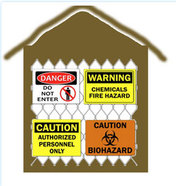
Universal Design has evolved as a way of designing public and private spaces to include the widest range of people with diverse ways of interacting with their environments. Most of the focus has been on disability and age--making all doorways wide enough for wheelchairs, having Braille signage in all elevators and anywhere there are instructions for the public, captioning all video, having work surfaces at multiple heights, tools that can be used with one hand, or low muscle strength, and built in flexibility, so a living space can change along with an aging resident's changing abilities. But, by and large, universal design hasn't addressed the needs of people like me, for whom the greatest barriers are chemical. For us, universal design doesn't stop at the front door. Our full inclusion requires designing the air, which means designing ecological societies that don't poison it. This is why my home on wheels isn't just a little house. It's why I've named it a Vehicle for Change. It will allow me to live, work and travel in greater health, but it will also help me raise these issues widely, wherever I go.

The Vehicle is both a solution to my own housing and travel challenges and a prototype that can be adapted to the needs of many other environmentally sick and disabled people. By incorporating chemical and neurological accessibility into my design, I am expanding the scope of universal design. I am also building and operating my home in the most sustainable way I can manage. Ultimately, inclusion and sustainability are the same thing. If my house doesn't support the continuation of human life, it can't be inclusive! Societies that are not inclusive waste the creativity and energy of the excluded, and are ultimately unsustainable. My definitions of universal design include the labor conditions of those who make the components of my house, what cultures are represented in its design and how, and the visual impact it will make as it moves through a varied landscape. Ecologically unsustainable societies distribute the consequences of their mistakes unevenly, creating unequal suffering, economic exclusion, the destruction of human as well as wild habitats and livelihoods. Sustainable societies must be able to sustain all people, all cultures, as well as the atmosphere, the oceans and the forests.
Some of the technology that would allow me to have a zero carbon footprint is not yet available, or not accessible to someone with my disabilities, but to the extent I am able, I am designing a home that sustains and includes my body, my community and my world.
Some of the technology that would allow me to have a zero carbon footprint is not yet available, or not accessible to someone with my disabilities, but to the extent I am able, I am designing a home that sustains and includes my body, my community and my world.
Universal Design for the Vehicle
 (Nerve axons, Edward C. Cooper, MD, PhD & Journal of Neuroscience)
(Nerve axons, Edward C. Cooper, MD, PhD & Journal of Neuroscience)
In applying UD principles to my Vehicle, I have focused on the following:
- Chemically safe materials. Not all "green" materials fall into this category. Renewable doesn't also mean non-toxic. My goal is to build and furnish with materials that won't pollute my indoor air or contribute to environmental degradation.
- Physically accessible design that allows me to avoid bending low, lifting high, significant physical exertion, and reduces the risk of injury from falling.
- Neurologically supportive design. My nervous system is less stable than many people's. I have epilepsy and get complicated migraines, both of which are affected by light. I need to avoid lights and computer screens that flicker, high contrast patterns like window blinds on a bright day, or bright, high contrast fabrics and paint. My choice of colors goes beyond personal taste or even mood setting, to how I regulate my neurological responses. Lighting with spectrum control can help me be alert and focused when I want to work, and relaxed when I am winding down for sleep.
I took all these challenges to Sean Solley's Interior Design class at the New England School of Art and Design, and got a wonderful brainstorm of ideas and drawings which you can look at in my design gallery.